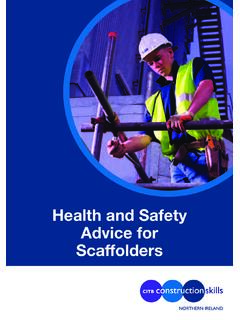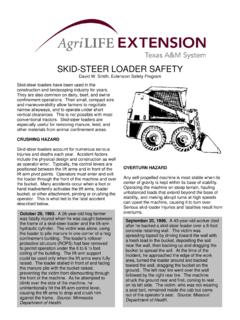Transcription of HEALTHANDSAFETY ADVICEFOR PLANTOPERATORS
1 HEALTH AND SAFETY. ADVICE FOR. PLANT OPERATORS. Where there are unsafe acts illustrated in the photographs - the scenarios were re-created for illustration purposes and no one was put at risk at any time. Contents Introduction 4. Plant Operator 6. Health and Safety Law 7. Health and Safety On Site 10. Health and Safety Training 11. Supervisors and Managers 14. Training of Plant Operators 19. Planning 21. Review and Monitoring 22. Site Conditions 22. Unauthorised use of plant 23. Visibility 24. Maintenance and Inspection 28. Overhead power lines 35. Lorry loaders (HIAB) 36. Passengers on Mobile Machinery 37. Forward Tipping Dumper (Site Dumper) 38. Roll Over Protective Structures (ROPS) 41. Selection of Attachments 42. Plant Operator Frequently Asked Questions. 46. Cranes 48. Skip Handler 52. Low loaders 57. 1. 360 Excavators (Diggers) 60. 180 Backhoe loaders (Digger Loader) 66. Loading Shovels 67. skid steer loaders 68. Trenchers 70. Graders 71. Bulldozers (Crawler tractors) 72.
2 Scrapers 73. Mobile Elevated Working Platforms (MEWP) 75. Forklift Trucks 78. Telescopic Handler 78. Working platforms on Forklift Trucks 84. Dump Trucks 86. Demolition Machines 87. Piling Rigs 89. Concrete Pumps 91. Slinging and Load Handling 93. Machine Recovery 94. Road Building plant and equipment 96. Crushers and Screeners 100. Drilling Equipment 102. General Health & Safety 103. Health, Hygiene and Welfare Facilities 103. Chemicals / Dermatitis 104. 2. Work Related Asthma 106. Dust and Flying Particles 107. Asbestos 108. Manual Handling 109. Power and Hand Tools 111. Hand-arm Vibration Syndrome (Havs) 112. Noise 114. Electricity 115. Struck or Crushed By Moving Vehicles on Site 117. Sun Exposure 118. Working at Heights 119. Access Equipment & Working Platforms 120. Step Ladders 121. Tower Scaffolds 123. Safety Critical Work 125. Safety in Confined Spaces 129. Safety in and Working Around Excavations 131. Personal Protective Equipment 135. Fire 136. First Aid 137.
3 CITB-ConstructionSkills NI 138. 3. This booklet is part of a range that have been produced by CITB-ConstructionSkills NI to provide advice and guidance on Health and Safety &. INTRODUCTION training issues relating to persons working in the Construction Industry such as Bricklayers, Joiners, Roofers, Plasterers, Painters & Decorators, Construction Operatives, Scaffolders, and Insulation Installers, with the aim of helping to eliminate and reduce the risk of, accidents, injury and ill-health. The booklets are in an easy to use pocket-size format and will be a good reference point to both existing and new entrants working in the industry and will also provide advice to supervisors, managers and directors to help improve health and safety performance on site. As there is a wide and ever increasing variety of mechanical plant and equipment in use in the construction Industry, all operators must be competent to perform their duties. Manufacturers and suppliers of mechanical Plant and equipment have a duty under Health and Safety Legislation to provide information on any hazards associated with their products and advise on their safe use.
4 Users should ensure they are in possession of this information, and make certain that the drivers and operators are instructed accordingly. Employers should establish a procedure designed to ensure that only authorised drivers and operators use their plant and equipment. It is recommended that drivers and operators should he issued with Certificates of Authorisation by their employers. Drivers should be in possession of an appropriate driving licence if machines are operated or driven on the public highway, Group H. for track laying vehicles and group G for Road Rollers. Unless proper provision has been made to carry passengers on a machine, or on any trailer being towed, the driver must be instructed not to carry passengers. Drivers must be aware that mobile plant should be parked on firm, level ground when unattended, with the 4. engine stopped, brakes on, and any load or attachment lowered to the ground. Some health and safety risks you may face on site include: Exposure to electricity.
5 Overhead and underground cables Falls from height Proximity to flammable or combustible materials Climbing steps and working platforms Risk of vehicle overturning Risk of eye injury from flying particles and dust. Cancer risk from Exposure to asbestos Slips trips and falls due to untidy work area Manual handling activities Using various types of machinery and tools. Moulds, fungi and bacteria. Dermatitis Cuts and abrasions Struck my machinery Loss of fingers/limbs Risk of pain or injury from performing repetitive tasks. Exposure to noise Struck by falling objects Vibration white finger Hand and foot injury Sun exposure Working in the construction industry is both rewarding and satisfying but as the above list shows you could be exposed to various risks if the correct safe methods of work as described in this booklet are not followed. Think about the various Health & Safety risks that could be found on your site, speak to your supervisor or person/s in charge about ways of eliminating or reducing those risks and stay healthy and safe.
6 5. As a construction plant operator, you provide a valuable service to the construction industry. You can be working on all types of construction PLANT. OPERATOR projects, including housing, factories, offices, roads, bridges, airports and many others. As a plant operator you could be operating one type of machine or a variety of machines during your lifetime such as earthmoving, lifting, processing, access and road construction equipment. The following list gives a flavor of the potential diverse tasks you could be involved in. Prepare building sites Digging shallow holes and trenches Digging Foundations Loading dumpers and trucks Stock pilling materials Demolition of buildings Lifting steel work and other products Lifting and placing pallets and mortar tubs Lifting roof trusses Clearing ground and levelling Cut and fill work Compaction of materials Laying of materials Transporting equipment Slinging loads Crushing and screening materials Accessing work at height Using hand and power tools As stated your role provides a valuable service to the construction industry but in order to sustain this valuable service you will need to have received adequate training specific to your work to ensure that you work safely and without risk to yourself and others, training also keeps you up to date with current Health & Safety to ensure you follow proper recognised procedures on site.
7 6. Your health, safety and welfare at work are protected by law, your employer has a duty to protect you and keep you informed about health and safety HEALTH AND. SAFETY LAW and provide adequate information, instruction, training and supervision to enable you to carry out your work in a safe manner. You have legal duties too as follows. Take reasonable care for your own health and safety and of others who may be affected by your work such as other workers or members of the public Comply with instructions or control measures such as the wearing of personal protective equipment. Co-operate with your employer on health and safety and training requirements. Correctly use and report any defects on work equipment provided by your employer this could be machinery, tools or personal protective equipment Do not interfere with or misuse anything provided for your health, safety or welfare. Self-employed persons also have duties under the law in relation to their own Health and Safety and ensure that their work does not put others at risk.
8 If you think there is a health and safety problem on your site you should first discuss it with your supervisor, H & S adviser or person in charge. Legal Requirements in relation to Plant Several pieces of legislation apply when it comes to the use of plant, and employers and operators need to be aware of the relevant legislation from the following: 7. Health and Safety at Work NI Order The Health and Safety at Work Order places duties on everyone, and states that Information, Instruction, Training and Supervision must be provided. Provision and Use of Work Equipment Regulations The Provision and Use of Work Equipment Regulations (PUWER) cover the selection, maintenance, general use and training aspects of all work equipment. The Lifting Operations and Lifting Equipment Regulations The Lifting Operations and Lifting Equipment Regulations (LOLER) deal with the actual lifting operation being carried out as opposed to the selection etc. of the equipment Work at Height Regulations These Regulations require all work at height to be properly planned and organised and the risks controlled.
9 This includes the selection and use of appropriate work equipment for work at height. The Regulations maintain existing standards with regard to the control of work at height and reiterate the provisions of PUWER and LOLER. The Construction (Design and Management) Regulations (Northern Ireland) CDM. The updated CDM regulations place a responsibility on everyone involved in the construction process, everyone needs to know about these regulations and that includes you. Workers: roles and responsibilities All those who work in the construction industry have their part to play looking after their own health and safety and in improving the industry's health and safety record. 8. Those with legal duties are commonly known as duty-holders'. Duty-holders under CDM are: Clients, CDM Co-Ordinators, Designers, Principal (main) Contractor, Contractors and Workers. Ensure you only carry out construction work if you are competent Report any defect that you think may endanger the health and safety of yourself, other persons or members of the public.
10 Co-operate with others and co-ordinate work so as to ensure your own health and safety and others who may be affected by the work. Follow site health and safety rules and procedures Contractors: roles and responsibilities On all projects contractors will need to: Plan, manage and monitor their work and that of workers Check the competence of all their appointees and workers Train their own employees Provide information to their workers Ensure all workers have site inductions and any further information and training needed for the work Ensure that there are adequate welfare facilities for their workers The CDM regs are supported by an Approved Code of Practice (ACoP). 9. A number of initiatives have been launched to promote and improve good practice and by HEALTH AND reducing accidents and ill health such as SAFETY ON SITE BuildHealth. BuildHealth was launched to improve the health of construction workers in Northern Ireland by: preventing work related ill health: supporting and rehabilitating ill workers and using the workplace as a setting in which to improve health.






